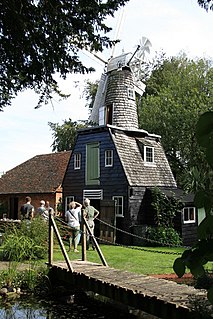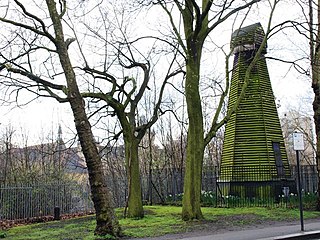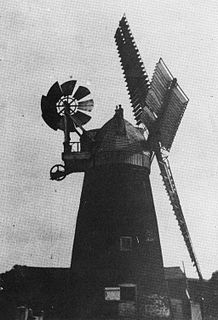
Heckington Windmill is the only eight-sailed tower windmill still standing in the United Kingdom with its sails intact.

A tower mill is a type of vertical windmill consisting of a brick or stone tower, on which sits a wooden 'cap' or roof, which can rotate to bring the sails into the wind.

East Runton Windmill is a grade II listed tower mill at East Runton, Norfolk, England which has been converted to residential accommodation.
Chislet windmill was a Grade II listed smock mill in Chislet, Kent, England. It was built in 1744 and burnt down on 15 October 2005.

Swingate Mill is a Grade II listed tower mill in Guston, Kent, England that was built in 1849.

Ringle Crouch Green Mill is a smock mill in Sandhurst, Kent, England, that was demolished to base level in 1945, and now has a new smock tower built on it as residential accommodation and an electricity generator.

Argos Hill Mill is a grade II* listed post mill at Argos Hill, Mayfield, East Sussex, England

Blackdown Mill or Cherry Clack Mill is a grade II listed smock mill at Punnetts Town, East Sussex, England, which has been restored.

Gibbet Mill, Tillingham Mill, Barry's Mill or New Mill is a grade II listed cosmetically reconstructed smock mill at Rye, East Sussex, England. Today it serves as bed and breakfast accommodation.

South Marsh Mill is a grade II listed tower mill at Arundel, Sussex, England which has been converted to residential use.

Stone Cross Windmill is a grade II* listed tower mill at Stone Cross, Sussex, England which has been restored and is open to the public. The mill was also known as Blackness Mill and the White Mill.

Buckland Windmill is a grade II listed smock mill at Buckland, Surrey, England which has been restored to working order. It is the only surviving wind saw mill in the United Kingdom.

Wandsworth Common Windmill is a conserved grade II listed smock mill at Wandsworth Common, in the London Borough of Wandsworth in the United Kingdom.

Hurt Wood Mill is a grade II* listed tower mill at Ewhurst, Surrey, England which has been converted to residential use.

Barnet Gate Mill or Arkley Windmill is a grade II* listed tower mill at Barnet Gate in the London Borough of Barnet, originally in Hertfordshire. There is no public access.

Stansted Mountfitchet Windmill is a grade II* listed Tower mill at Stansted Mountfitchet, Essex, England which is also a Scheduled Ancient Monument. It has been restored and can turn by wind.

Bardwell Mill is a Grade II* listed tower mill at Bardwell, Suffolk, England which is under restoration.

Thelnetham Windmill, also known as Button's Mill is a Grade II* listed tower mill constructed of brick. The windmill is located at Thelnetham, Suffolk, England. It was built in the early nineteenth century to grind wheat into flour. Thelnetham windmill worked by wind power until 1924, latterly on two sails, after which it became derelict.

Pakenham Mill is a Grade II* listed tower mill at Pakenham, Suffolk, England which has been restored and is maintained in working order.

Holgate Windmill is a tower mill at Holgate in York, North Yorkshire, England which has been restored to working order.



















